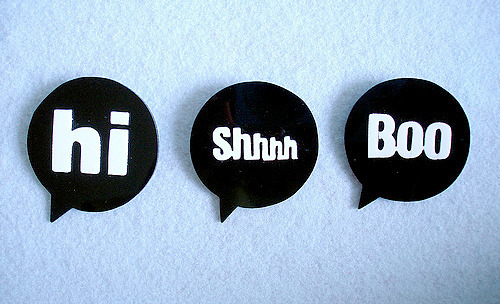Five Mistakes to Look For In Your Dialogue

The “Now What?” Months are here! In 2014, we’ll be bringing you advice from authors who published their NaNo-novels, editors, agents, and more to help you polish November’s first draft until it gleams. Today, Cara Lockwood, author, editor, and NaNo sponsor , spotlights five dialogue potholes:
Good dialogue is hard for even experienced writers to get right. Bad dialogue, however, can be a major red flag to agents, publishers and readers in general that you are a novice writer not ready to be published. I’ve helped many first-time writers correct the most common missteps with dialogue, such as:
Flat dialogue
Often, a character’s speech can come out too stilted. I always think it’s a good idea to read dialogue aloud to make sure it sounds authentic.
Stilted dialogue sounds like:
“I have thought about it extensively and I do not believe I am a morning person,” Allison said.
That speech only works if your novel is set in Downton Abbey.
Too-long Monologues
While everyone agrees Shakespeare is a genius, no one wants to read a Shakespeare-length monologue in the middle of a novel. If your dialogue goes on for more than three sentences, consider breaking up the speech with some descriptions of what the speaker is doing, or how the listener is reacting.
Colorless Dialogue
When characters talk, readers still need to know what’s going on in the scene. Add descriptions, such as:
“I’m not a morning person,” Allison admitted, as she reached for her mug of hot coffee.
Rhythmless Dialogue
Dialogue that starts to feel like a screenplay can be too blah:
“I’m not a morning person,” she said.
“Really? I am,” he said.
“I love coffee, though,” she said.
“Me, too,” he said.
Not every line of dialogue needs “he said” or “she said.” Repetition can kill your flow. You also lose out on ways to communicate meaning in between the lines.
Consider this example:
Allison reached for her coffee mug. “I’m not a morning person.” She took a sip.
Her boyfriend, Mike, moved to her side. “Really?” He slid his arm around her waist and playfully nuzzled her neck. “I am.”
See how the meaning of the conversation changes? And I bet you didn’t miss “he said” or “she said.”
Expositional Dialogue
Dialogue can help you advance your plot, but it should not be the only way you do so. Remember, the best novels show us the action, they don’t tell us about it. Having a character spend too much time explaining your plot will drag down your novel’s pace.
Cara Lockwood is the USA Today bestselling author of eleven novels. She’s also the owner and chief editor at Edit-My-Novel.com, which helps new writers improve their work.
Top photo by Flickr user Streetfly_JZ.
Chris Baty's Blog
- Chris Baty's profile
- 62 followers




